French Type Constructed Wetlands for Sewage Treatment: Experiences from the SWINGS Prototype in India
1
Department of Civil Engineering,
Zakir Husain College of Engineering and Technology,
Aligarh Muslim University,
Aligarh,
Uttar Pradesh
India
2
Department of Science and Technology,
Ministry of Science and Technology,
Government of India,
New Delhi
India
3
LIMNOS Podjetje za aplikativno ekologijo d.o.o,
Company for Applied Ecology Ltd,
Podlimbarskega,
Ljubljana
Slovenia
Corresponding author Email: nkhalil.cv@amu.ac.in
DOI: http://dx.doi.org/10.12944/CWE.17.2.16
Copy the following to cite this article:
Khan U. M, Kumar A, Zalaznik A, Khalil N. French Type Constructed Wetlands for Sewage Treatment: Experiences from the SWINGS Prototype in India. Curr World Environ 2022;17(2). DOI:http://dx.doi.org/10.12944/CWE.17.2.16
Copy the following to cite this URL:
Khan U. M, Kumar A, Zalaznik A, Khalil N. French Type Constructed Wetlands for Sewage Treatment: Experiences from the SWINGS Prototype in India. Curr World Environ 2022;17(2).
Download article (pdf)
Citation Manager
Publish History
Select type of program for download
| Endnote EndNote format (Mac & Win) | |
| Reference Manager Ris format (Win only) | |
| Procite Ris format (Win only) | |
| Medlars Format | |
| RefWorks Format RefWorks format (Mac & Win) | |
| BibTex Format BibTex format (Mac & Win) |
Article Publishing History
| Received: | 2022-06-22 |
|---|---|
| Accepted: | 2022-09-02 |
| Reviewed by: | 
 Pradeep Paliwal
Pradeep Paliwal
|
| Second Review by: |

 Prof. Li Guangming
Prof. Li Guangming
|
| Final Approval by: | Dr. Gangadhar Andaluri |
Introduction
In Indian sub-tropical climatic conditions, nature-based solutions (NBS) like constructed wetlands technology for sewage treatment are also gaining popularity over the other methods1,2,3. For small flows, constructed wetlands (CWs) have been a proven, cost-effective, and easy-to-implement method with low O&M costs compared to conventional high-rate treatment systems4,5. One of the most promising configurations of the CWs is the French Type wetland system for wastewater treatment 6. In contrast to the conventional CWs, the FTCW can treat raw wastewater directly without any primary treatment and is easy to deal with sludge management7. The FTCW can be either a single-stage or a two-stage hybrid system. In the latter case, the first stage involves a vertical sub-surface flow (VSSF) bed receiving raw wastewater directly (without any primary treatment) whereas the second stage is a horizontal sub-surface flow (HSSF) bed, both filled with media8.
In countries having sub-tropical climatic conditions as prevailing in the major part of northern India, and in similar regions of its sub-continent, wetlands have an advantage over the colder regions8. The growth of macrophytes and enhanced microbial activities are the main factors due to which CWs offer higher removal efficiencies in these regions7,14.
Literature suggests that FTCWs have been widely adopted for wastewater treatment9. In the previous studies, and from the results of the full-scale installations that are in operation, the HLR are ranging from 0.37 m/d to 0.45 m/d1 ,10. The organic loading rates are generally kept in between 150 and 300 g COD m-2·d-1and whereas TKN ranges in between 25 and 30 g.m-2·d-111,13. Another important factor in the good design practices of the FTCW is the selection of the macrophytes12. In most of the cases, as has been reported in the literature, phragmites australis is the most common specie used in the FTCW12.
In this study, hybrid FTCW was designed at a pilot scale level in the two stages (vertical flow and horizontal flow) with three different plants (phragmites australis, canna indica, and sagittaria) with the objective to investigate its performance in the removal of the pollutants from the sewage in a real field under sub-tropical climatic conditions. The secondary objective was to investigate the impact of different species on the performances under varying hydraulic loading conditions.
Materials and Methods
The study was carried out at the Aligarh Muslim University (AMU), Aligarh in India. The city (27o88’N, 78o08’E) is situated in the northern part of India and about 130 km southwest of the capital city, Delhi (Figure 1). The climate is sub-tropical with high temperatures (27oC to 46oC) in summer and humid and cold (10oC to 1oC) during the winter season. The rainy season also lies in between summers and winters with an average annual rainfall of about 590 mm.
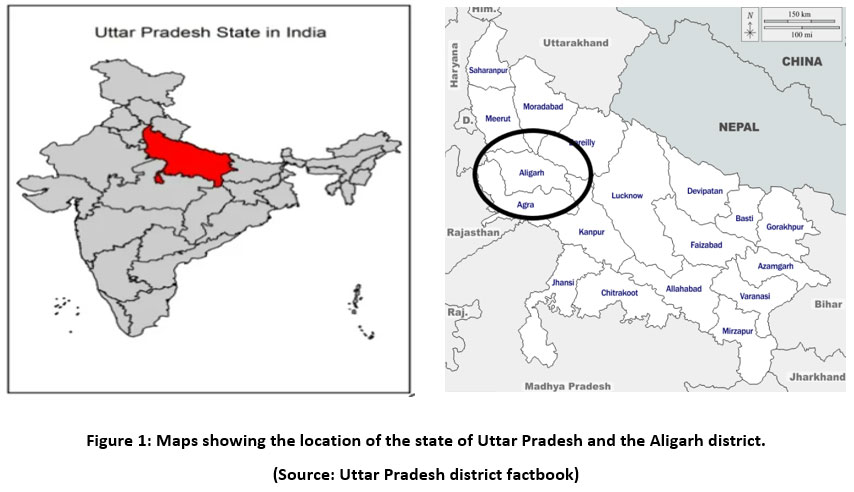 | Figure 1: Map of India showing the location of Aligarh (Source: www.dmaps.com).
|
The pilot set-up was constructed of concrete within the Indo-European SWINGS Research Project. It consisted of a screen chamber, grit channel, holding tank, and hybrid wetlands in two stages: a vertical sub-surface flow with 3 beds in parallel followed by a horizontal sub-surface flow wetland (Figure 2). The two stages of the French CW system have a net area of around 82 m2 (36.75 m2 for the first stage and 45 m2 for the second stage) designed to be operated at a variable hydraulic loading rate (0.4m/d to 0.97 m/d). The raw sewage was made available from the adjoining and existing sewage treatment plant (STP) of the university campus where this pilot study was conducted.
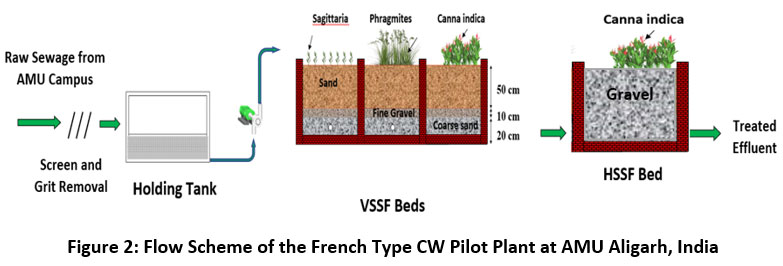 | Figure 2: Flow Scheme of the French Type CW Pilot Plant at AMU Aligarh, India.
|
The raw sewage was tapped from the inlet chamber of the STP to the holding tank of the pilot set-up. Table 1 shows the dimensions and type of filter media used in the construction of VF and HFCW units and the design parameter details are given in Table2.
Table 1: Key Features of the Construction.
VSSF CW | HSSF CW |
Number of beds: 03 | Number of beds: 01 |
Length: 3500mm or 3.5 m | Length: 10000mm or 10 m. |
Width: 3500mm or 3.5 m | Width: 4500mm or 4.5 m. |
Depth: 800mm or 0.8 m | Depth: 500mm or 0.5 m. |
Media | Media: |
From the top to the bottom | 6-16 mm Ø gravel
|
50 cm of 2-4 mm Ø sand | |
10 cm of 6-16 mm Ø gravel | |
20 cm of 20-40 mm Ø gravel |
Table 2: Details of design parameters of different pilot units of FTCW.
Different units | Effective area (m2) | Water depth (m) | HRT (hours) | Loading rate (m3/day) | Effective volume(m3) | Plantation |
Bed 1 | 12.25 | 0.97 | 17 | 5,10,12 | 11.88 | Canna indica |
Bed 2 | 12.25 | 0.97 | 17 | 5,10,12 | 11.88 | P. australis |
Bed 3 | 12.25 | 0.97 | 17 | 5,10,12 | 11.88 | Sagittaria |
Operations, Sampling, and Monitoring
The first stage (VSSF) was operated in a sequential mode: each bed was fed with raw sewage directly for 3.5 days followed by twice the time resting period of 7 days. Figure 3 shows the view of the pilot VSSF CW and HSSF CW units in Aligarh during the initial stages and after achieving steady-state conditions respectively.
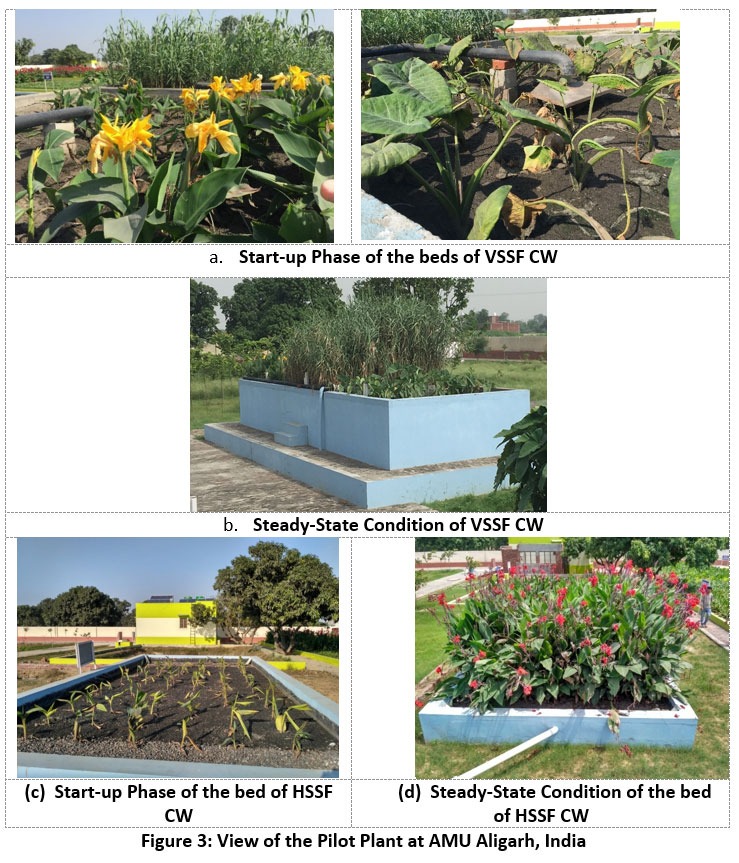 | Figure 3: View of the Pilot Plant at AMU Aligarh, India.
|
The pilot plant was operated and monitored for a period of 2 years for three variable HLRs of 0.4, 0.81 and 0.97m/day at a pulse loading of a single bed. Locally available native plants were used in the study. Each compartment of stage 1 was planted with different species. These were Canna indica, Phragmites australis, and Sagittaria. The wastewater was distributed uniformly over the top of the bed surface through perforated pipes perpendicular to the water flow 10 cm below the surface. Drainage pipes were installed at the bottom of the beds perpendicular to the flow at the other side of the filter. The purpose of HSSF CW was to polish the treated wastewater from VF beds on a continuous basis15. This single bed of stage two in this study (HSSF CW) was vegetated with Canna indica.
After the steady-state condition, the monitoring of the plant was carried out over a period of two years. The study was started in the year 2017 and completed in 2019. The system took about 4-5 months to reach the steady-state condition after the vegetation was planted in the beds. After attaining good growth of macrophytes with proper development of shoots and root zones in all the beds, regular sampling and monitoring were started. The sampling was carried out for Physico-chemical pollutants. The wastewater parameters such as temperature, pH, electrical conductivity, and dissolved oxygen (DO) were recorded with a multimeter on an in-situ basis where BOD5, COD, TSS, TN, and TP were analyzed in the Environmental Engineering Laboratory, Department of Civil Engineering, AMU, Aligarh. Grab samples were collected in properly prepared clean and acid-washed bottles and the samples were transported in a refrigerated box while maintaining a temperature of 4? to the laboratory. For analysis purposes, the procedures given in the Standard Methods for Water and Wastewater Examination (APHA, AWWA, WEF, 2005) were used.
Results and Discussions
The mean concentrations of the wastewater contaminants are presented in Table 3. For the domestic wastewater available, the mean of the fluctuations of the inlet concentrations in all three beds over its cyclic loading was observed in terms of COD (125.51 ± 31.9 mg/l), BOD5 (68.58 ± 17.1 mg/l), and TSS (43.48 ± 9 mg/l).
Table 3: The mean concentration of raw, untreated wastewater observed over 2 years period.
Parameter | Influent and Effluent Concentrations in (mg/l) |
| |||||||||
Vertical Flow Constructed Wetlands (FTCW) | After HFCW |
| |||||||||
BED 1 | BED 2 | BED 3 |
| ||||||||
In | Out | In | Out | In | Out | BED 1 | BED 2 | BED 3 |
| ||
BOD
| Mean±SD |
66.67±17 |
22±9.1 |
69.48±17.5 |
20.25±10.8 |
69.61±16.8 |
25.93±10.7 | 8.74±4.7 | 9.03±4.8 | 9.29±4.9 |
|
COD
| Mean±SD |
120±24.7 |
36.73±14.4 |
128.4±39.7 |
33.73±16.4 |
128.13±31.5 |
44.66±17.6 | 15.73±7.9 | 14.66±6.7 | 19.33±10.4 |
|
TSS
| Mean±SD |
42.37±9.6 |
8.4±2.2 |
42.95±9.9 |
8.02±3 |
45.13±7.7 |
8.57±3 | 6.98±2.4 | 6.42±3 | 6.76±3.1 |
|
The first stage efficiency after the influent passed through the three vertical flow beds planted with the three macrophytes species was observed as
Canna indica: 70.3%, 67.93% and 79.99% for COD, BOD5 and TSS respectively;
Phragmites australis: 74.47%,71.91% and 81.32% for COD, BOD5 and TSS, respectively and Sagittaria: 66.11%,63.76% and 81.09% for COD, BOD5 and TSS, respectively.
The second stage of treatment involved a horizontal flow CW planted with Canna indica species which further enhanced the quality of treated effluent from the vertical flow beds by removing the contaminants. Stage 2 efficiency was observed as
Canna indica: 58.07%, 62.07% and 18.27% for COD, BOD5 and TSS, respectively,
Phragmites australis: 55.02%,55.07% and 22.02% for COD, BOD5 and TSS, respectively; and Sagittaria: 58.38%,65.58% and 23.01% for COD, BOD5 and TSS, respectively.
The overall efficiency of the French-type CWs system was observed as 87.1%, 87.3%, and 84.6% for COD, BOD5, and TSS, respectively. Stage 1, Stage 2, and overall efficiency are shown in Figures 4 (a), (b), and 3(c) respectively.
The use of variable filter media such as gravel and sand for the vertical flow CWs also affected the treatment process by enhancing the growth of microorganisms and the development of the sludge layer on top of the beds16. The removal efficiencies of nutrients like TN and TP were also assessed. The treatment efficiency measured for TN and TP is 67.93% and 69.32% respectively (Fig.4 (d)). These efficiencies were observed to be comparable to those reported for domestic wastewater13, which can be most likely due to the favourable growth conditions for macrophytes and microorganisms in a climatic condition as was prevailing in the study region12.
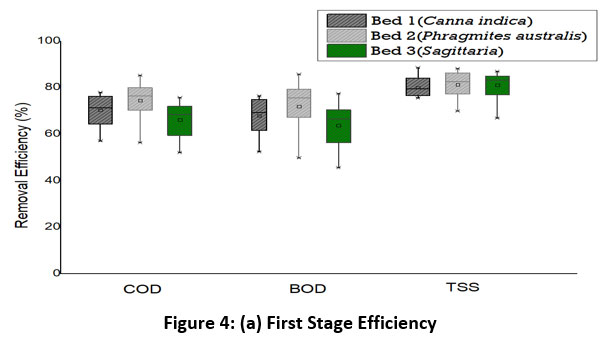 | Figure 4: (a) First Stage Efficiency.
|
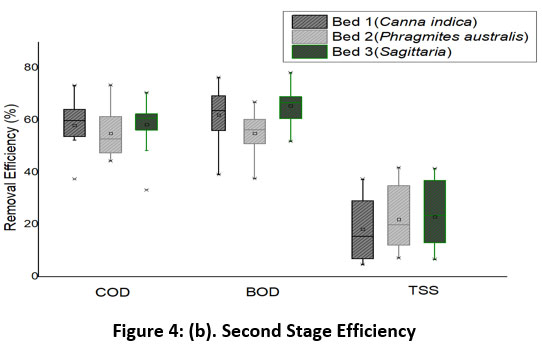 | Figure 4: (b). Second Stage Efficiency
|
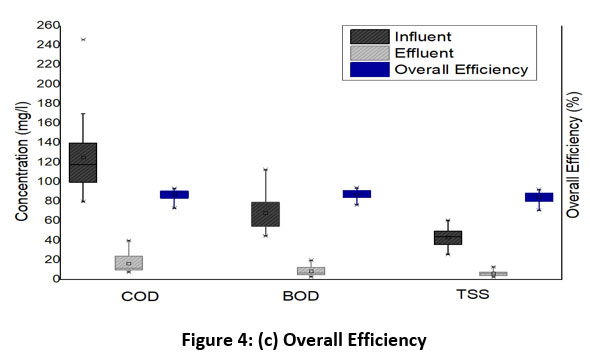 | Figure 4: (c) Overall Efficiency.
|
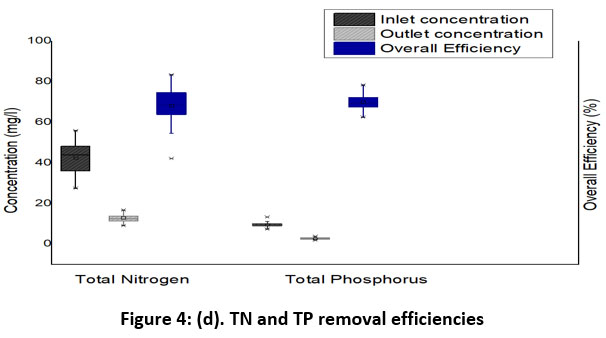 | Figure 4: (d). TN and TP removal efficiencies.
|
Influence of Variable influent flow rates on the Performances
The influent flow rate was varied for the performance evaluation of the French system of CWs during the assessment and monitoring period. The HLR was gradually changed from 0.4m/d, 0.81m/d, and finally to 0.97m/d over a monitoring period. Varying HLR resulted in a change in stage 1, and stage 2, and the overall efficiencies of the system10. However, a significant change was not observed in the removal efficiencies when the HLR varied from 0.81m/day to 0.97m/day. It was observed that there was a decrease in the removal efficiencies of the pollutants with the increase in influent flow rates 10,20,21 ( Fig.5). The removal rates observed for the overall system for COD, BOD5, and TSS at different HLRs are as at 0.4m/day: 87.15%, 87.37%, and 84.66%; At 0.81m/day: 84.68%,85.40%, and 83.60% and at 0.97m/day: 84.24%,84.43%, and 83.49% respectively.
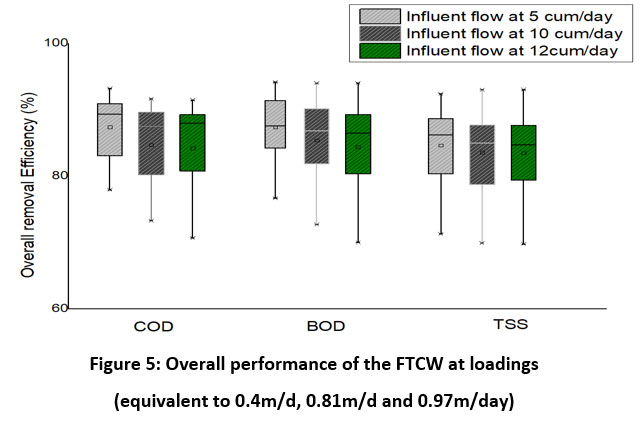 | Figure 5: Overall performance of the FTCW at loadings (equivalent to 0.4m/d, 0.81m/d and 0.97m/day).
|
During the commissioning phase, low efficiencies were observed. This can be attributed to less deposition of the sludge layer on top of the filter beds thereby reducing the interaction between the macrophytes and micro-organisms11,16,17. However, once the steady condition was reached during the course of this study, it was observed that the performance of the FTCW improved with time and this can be attributed to the deposition of the sludge layer on top of the vertical flow beds and its role in the removal process11,14,17. The study is also in concurrence with the previous studies that mineralization of the sludge layer increases the capacity of the treatment system and the effect of low influent flow increases the contact time between wastewater and microorganisms11,17. The decrease in second stage efficiency was observed due to the better removal efficiency by the first stage VF beds18,20.
Conclusion
Two years of monitoring data of the pilot plant based on the hybrid French-type constructed wetlands configuration in real field conditions under the Indian sub-tropical climatic conditions has shown average removal efficiencies (overall) for the parameters COD, BOD5, TSS, TN, and TP of 87.1%, 87.3%, 84.6%,67.93%, and 69.32% respectively. Out of the three VSSF beds with a different plantation, the bed with sp. Phragmitesaustralis has shown the highest removal efficiency at an HLR of 0.4m/d followed by sp. Canna indica and sp. sagittaria. The efficiencies gradually reduced when the HLR was increased from 0.4m/d to 0.81m/day and further to 0.97m/day. This shows that by lowering the hydraulic retention time, the efficiency of the stage 1 system decreases, and ultimately it has an impact on the overall water quality. Once the steady state condition is reached, the quality of the treated effluent after the second stage of treatment was found within the permissible Indian limits for disposal in the surface water. The findings showed that the French Type CW in a hybrid configuration can be a very promising way to deal with sewage in India or in regions having similar climatic conditions.
Acknowledgment
The authors would like to acknowledge the support and cooperation received from the Aligarh Muslim University, India for providing land to set up the pilot plant within their premises, conducting experiments, and using the Laboratory facilities.
Conflict of Interest
The authors do not have any conflict of interest.
Funding Sources
The study was carried out from the research grant received from the Department of Science & Technology (DST) Government of India, New Delhi (DST/IMRCD/2012/(G)/i), and European Union's Seventh Framework Programme for research under Grant Agreement Nº308502.
References
- Kania M, Gautier M, Imig A, Michel P, Gourdon R., “French vertical flow treatment wetlands in a subtropical climate: Characterization of the organic deposit layer and comparison with systems in France” Science of the Total Environment 647,2019; 464–473.
CrossRef - Brix H., “Danish guidelines for small-scale constructed wetland systems for onsite treatment of domestic sewage.” In: Proc. Of the 9th International Conference on Wetland Systems for Water Pollution Control, IWA, Avignon, France, 2004; Vol.1, 26-30: pp. 1-9.
CrossRef - Liquete, C., Udias, A., Conte, G. Grizzetti, B., Masi, F. Integrated valuation of a nature-based solution for water pollution control. Highlighting hidden benefits. Ecosyst. Serv. 2016; 22: pp. 392–401.
CrossRef - Geenens, D., Thoeye, C. Cost efficiency and performance of individual and small-scale treatment plants. Water Sci. Technol. 2000;41: 21–28.
CrossRef - Masi F., Rizzo A., Regelsberger M. “The role of constructed wetlands in a new circular economy, resource-oriented, and ecosystem services paradigm.” J. Environ. Manag. 2018; 216: pp.275–284.
CrossRef - Rizzo, A., Bresciani, R., Martinuzzi, N., Masi, F “French reed bed as a solution to minimize the operational and maintenance costs of wastewater treatment from a small settlement: an Italian example”. Water, 2018; 10(2):156.
CrossRef - Molle P, Liénard A, Boutin C, Merlin V, and Iwema A. "How to treat raw sewage with constructed wetlands: an overview of the French systems." Water Science and Technology 51,2005; no. 9: pp. 11-21.
CrossRef - Lombard-Latune R, Leriquier F, Oucacha C, Pelus L, Lacombe G, Guennec B.L and Molle P. “Performance and reliability comparison of French vertical flow treatment wetlands with other decentralized wastewater treatment technologies in tropical climates.” Water Science & Technology, 2020;82.8
CrossRef - Morvannou A., Forquet N, Michel S, Troesch S, and Molle P. "Treatment performances of French constructed wetlands: results from a database collected over the last 30 years." Water Science and Technology 71, 2015; no. 9: pp. 1333-1339.
CrossRef - Moraes A, García J, Trein C, Ferreira V, and Sperling M. “Outflow dynamics in a French system of vertical wetlands operating with an extended feeding cycle.” Water Science & Technology, 2019;79.4
CrossRef - Trein C, García J, Zumalacarregui, Moraes A and Sperling M “Reduction of area and influence of the deposit layer in the first stage of a full-scale French system of vertical flow constructed wetlands in a tropical area.” Water Science & Technology, 2019;80.2
CrossRef - Lombard Latune R , Laporte-Daube O , Fina N , Peyrat S , Pelus L , Molle P “Which plants are needed for a French vertical-flow constructed wetland under a tropical climate?” Water Sci Technology, 2017;75(7-8):1873-1881.
CrossRef - Yadav A, Chazarenc F, and Mutnuri S. “Development of the French system vertical flow constructed wetland to treat raw domestic wastewater in India”. Ecological Engineering, 2018;Volume 113: Pages 88-93
CrossRef - Paing J., V. Serdobbel M. Welschbillig, M., Calvez, Gagnon V., and Chazarenc F. "Treatment of high organic content wastewater from food-processing industry with the French vertical flow constructed wetland system." Water Science and Technology 72, 2015; no. 1: 70-76.
CrossRef - Vymazal J. "Horizontal sub-surface flow and hybrid constructed wetlands systems for wastewater treatment." Ecological engineering 25, 2005; no. 5: pp.478-490.
CrossRef - Chazarenc, F., and Merlin. "Influence of surface layer on hydrology and biology of gravel-bed vertical flow constructed wetlands." Water Science and Technology 51, 2005; no. 9: pp. 91-97.
CrossRef - Molle P. "French vertical flow constructed wetlands: a need of a better understanding of the role of the deposited layer." Water Science and Technology 69, 2014; no. 1: pp. 106-112.
CrossRef - Saleth, R. M. Water scarcity and climatic change in India: the need for water demand and supply management. Hydrol. Sci. J. 2011; 56(4): pp. 671–686.
CrossRef - Boutin C, Boucle S, and Boucher M. "Robustness of vertical reed bed filters facing loads variations: The particular case of campsites." In 12th International Conference on Wetland Systems for Water Pollution Control, 2010; pp.177-185.
- Cooper P. "The performance of vertical flow constructed wetland systems with special reference to the significance of oxygen transfer and hydraulic loading rates." Water Science and Technology 51, 2005; no. 9: pp.81-90.
CrossRef - Paing J, Guilbert A, Gagnon V, and Chazarenc F. "Effect of climate, wastewater composition, loading rates, system age and design on performances of French vertical flow constructed wetlands: a survey based on 169 full-scale systems." Ecological Engineering, 2015; 80: pp. 46-52.
CrossRef






